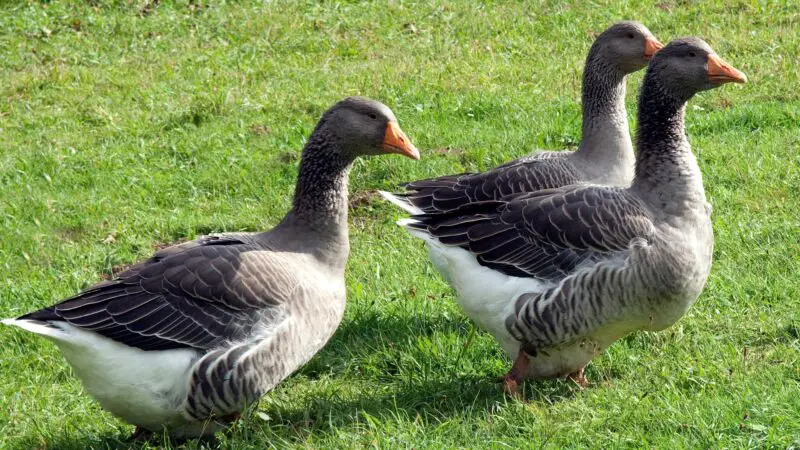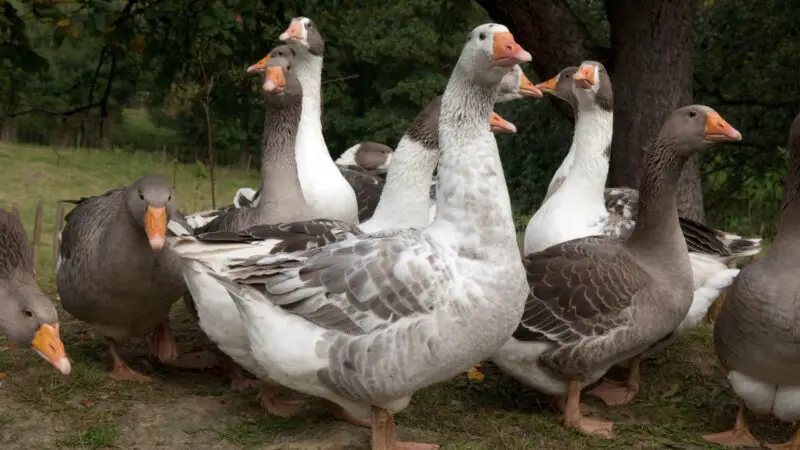The first step in owning and raising pet geese in your backyard is choosing the ideal breed for you. If you desire a goose that’s perfect for creating a colorful but sophisticated home flock, then the Pomeranian goose might be what you’re looking for.
A Pomeranian goose is a medium-sized goose with a rounded body, single-lobed paunch, stout neck, and protruding breasts, giving them an arrogant appearance. It comes in four color varieties: white, gray, saddleback buff, and saddleback gray. It is primarily raised for their meat.
If you want to know more about the Pomeranian goose, its origins, distinctive characteristics, temperament, and other interesting information, simply read further this article!
Pomeranian Goose History

The Pomeranian goose referred to as the L’oie de Pome’ranie, Pommerngans, or Rügener goose in native German, was developed in the 16th century by North German farmers by using the European Greylag goose to create a bird with a single-lobed paunch. It was a popular breed in Europe, especially in Germany and in Baltic or Eastern European countries.
Despite being specifically crossbred for the development of a single-lobed paunch, the breed still often has two lobes in North America due to inbreeding and genetic variation. Additionally, it is unknown what the European Greylag was bred with to produce the Pomeranian. There are speculations that it was the Toulouse and Embden, but neither is scientifically proven.
It was then introduced in the United States through early German settlement. Despite the goose being officially distinguished as a breed in 1912, it was not until 1977 that the American Poultry Association included the Pomeranian in their Standard of Perfection. Only two—Buff Saddleback and Saddleback Gray—out of the four color varieties of the bird are recognized.
Today, the Pomeranian is still a popular breed in Germany, Austria, Slovakia, Poland, and the Czech Republic but has since declined in population in the US due to the fall of traditional family farms and the decreasing importance of goose in American agriculture. As such, the Livestock Conservancy categorizes the breed as threatened.
Are Pomeranian Geese Aggressive?
Pomeranian geese are aggressive since they are a nervous bunch and may resort to aggressive behavior. However, not all birds display this as some have docile and pleasant temperaments.
Pomeranian Goose Identification

What Do Pomeranian Geese Look Like?
They are chunky and round-bodied geese with slightly flattened heads, single-lobed paunches, protruding breasts, and stout necks, giving them an arrogant-looking appearance. Pomeranians inherited the reddish-orange legs and feet, pinkish-red bill, and blue eyes from the European Greylag.
Pomeranians are available in four color varieties: white, gray, saddleback gray, and saddleback buff. The most common type is the saddleback gray and saddleback buff which means their head, flanks, and back are either gray or buff.
How Long Does a Pomeranian Goose Live?
About 10 to 20 years as long as they are well taken care of.
What Do Pomeranian Geese Eat?
Pomeranian geese, like all other geese, primarily eat grass. Grass comprises up to 70% of their diet. They will also feed on insects, fish, aquatic plants, and commercial waterfowl feed, which has different varieties depending on age.
How Big Do Pomeranian Geese Grow?
They can grow an average of 7 to 12 inches in height.
Are Pomeranian Geese a Heavy Breed?
Pomeranian geese are of average weight with females weighing 13 to 15 pounds while ganders can reach up to 17 pounds in weight or heavier.
Pomeranian Goose Wingspan
There is currently no information regarding the wingspan of the Pomeranian goose.
What Is Pomeranian Goose Known For?
Pomeranian geese are primarily raised for meat. During the colonial period, they were popular as a dual-purpose breed since they were great table birds and were also used for smoked goose breasts.
Where Do Pomeranian Geese Originate?
They originate from Pomerania, a region in Northern Germany.
What Are the Distinct Characteristics of a Pomeranian Goose?
Pomeranian geese are an all-around goose breed known for their single-lobed paunch. They also come in four color varieties so there’s more to choose from.
When Do Pomeranian Geese Lay Eggs?
Pomeranian geese begin laying eggs in the spring season, sometime between August to September. Breeders will usually encourage early egg production so that the geese are of marketable weight and age during the holidays.
How Old Is a Goose When It Starts Laying Eggs?
Geese will come into lay as early as 9 months of age, but they typically reach maturity at 2 years old.
How Often Do Pomeranian Geese Lay Eggs?
The Pomeranian goose will lay one clutch per season, producing about 1 egg every 4 to 6 days.
What Color Are Pomeranian Goose Eggs?
Pomeranian geese eggs are large and white.
Are Pomeranian Goose Eggs Good to Eat?
Pomeranian goose eggs are good to eat, but they are an acquired taste since they have a stronger flavor compared to chicken and dug eggs.
Pomeranian Geese Care Tips
Housing
Avoid restricting the geese in a constantly confined house, except during the winter season when they need to be sheltered. It does not even need to be elaborate, as long as it can protect from extreme temperatures and precipitation. Each goose should be provided with 10 square feet of floor space.
Feeders and Waterers
Use a simple box-type open feed trough, then place it on floor level with the geese. You can also use hanging-type feeders. As much as possible, place the feeders indoors.
For water, you can place it in any container, such as troughs, buckets, and pens, and even install automatic waterers. Place them outside of the house so that the sleeping area of the geese remains dry.
Waterers should be sufficiently wide and deep for the waterfowl to dip their heads and beaks into the container. Make sure to provide fresh, clean water every day.
During the winter season, if there is snow available, provide the geese with water once a day only and at least twice a day if there is no snow.
Nutrition
Grass makes up a bulk of the goose’s diet. Ladino clover and other types of white clovers are great choices for pasture grass as well as timothy, bluegrass, bromegrass, and orchard grass. Small grubs such as rye, wheat, and barley may also be provided. Additionally, you can also provide commercial waterfowl feeds.
Fencing
Fields and pastures should be fenced to keep predators away from the geese and also to prevent the geese from straying too far from your backyard. Woven wire fencing is sufficient to confine birds that are 4 to 6 weeks or older.
For younger birds, 2-inch mesh poultry netting is the most used. For adult geese, 18 inches to 2 feet of fencing is sufficient.
Breeding Pomeranian Geese
- Although a special building is not necessarily required for breeding small flocks of Pomeranians, it is still a good option to have at least a small building, such as a barn or garage, dedicated to brooding geese.
- The brooder house should be well-lighted, well-ventilated, dry, and draft-free. Half a square foot of floor space should be given to each bird at the beginning of the brooding period then increase to 1 square foot in 2 weeks.
- Confine goslings near a heat source or to a heated area for the first 3 to 4 days with a wire mesh or corrugated paper fence encircled around the brooder.
- When feeding goslings, you can create your starter feed by combining grounded grains (yellow corn, wheat or milo, barley, and oats), meat scrap, soybean oil meal, dried whey, iodized salt, and dehydrated alfalfa meal, and add some supplements such as riboflavin, vitamin B12, niacin, and dicalcium phosphate.
- The same ingredients can also be used for grower-finisher feeds but without supplements, dried whey, and dehydrated alfalfa meal.
- Provide goslings with lawn clippings or succulent pastures as early as their first week of age so that they can eventually develop a heavy dependence on pasture grass. You can also provide pea silage or corn if available.
Pomeranian Geese Common Health Issues

They are vulnerable to foot issues such as pressure sores and bone infections. Limb deformities, intestinal parasites, and trauma caused by predators are also common health issues among Pomeranian geese. Female geese may even be subjected to reproductive problems such as egg binding.
Related Questions
Are Pomeranian Geese Rare?
They are relatively rare in the United States but are somewhat widespread throughout Europe, especially in Germany and Poland.
Do Pomeranian Geese Make Good Pets?
Pomeranian geese are good pets since they are docile, social, pleasant, and quite chatty. Although owners must have to be wary since they, especially males, may become aggressive.
Do Pomeranian Geese Go Broody?
Most of the eggs they produce are fertilized well.
How to Tell Male From Female Pomeranian Geese?
Since male and female Pomeranian geese virtually have no physical differences, identification of sex is through examination of the event, much like how sex is identified in chickens. This method is best left to a qualified professional since any inexperienced person may cause damage or trauma to the sexual organs.
Do Pomeranian Geese Fly?
Pomeranian geese cannot fly. It is hard for them to do so due to their size and weight.
Can You Eat a Pomeranian Goose?
You can eat Pomeranian goose. Pomeranian geese are a meat breed.
List of Sources
Brooding and Rearing Ducklings and Goslings
